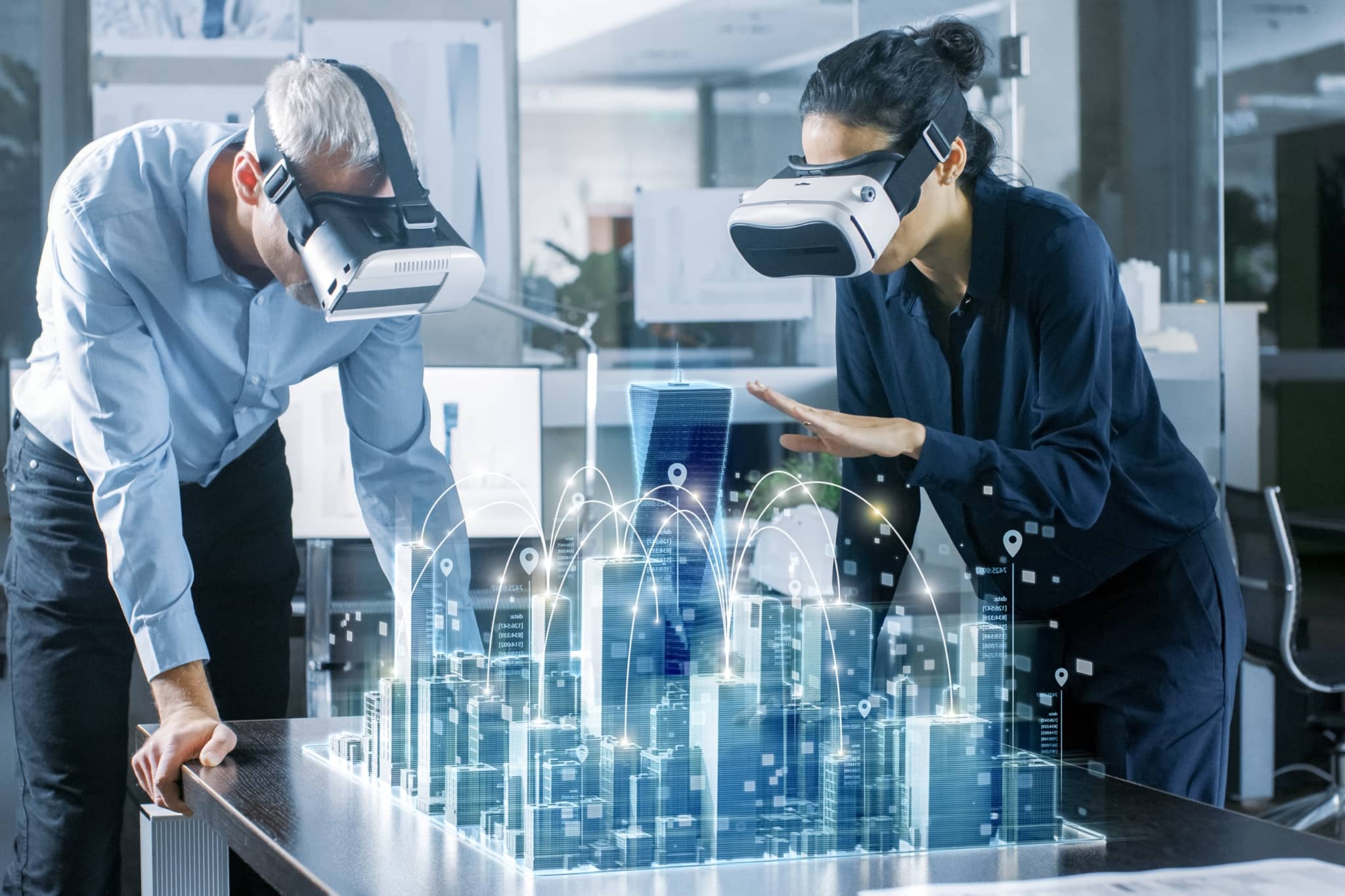
Artificial intelligence, metaverse… what are the challenges for recruitment?

If artificial intelligence (AI) is already very present in our daily lives (GPS, playlists, targeted advertisements) and is gradually becoming more popular thanks to tools such as ChatGPT, the metaverse is still in its infancy. These new technologies, which have enormous potential for development, are gradually being integrated into companies for human resources management, and, in particular, recruitment. What are the possibilities offered by these new algorithms? Do they help to recruit better? If so, will they eventually replace recruiters?
What do we mean by artificial intelligence (AI) and the metaverse?
These technologies, which are increasinly become part of everyday and work life, each have very distinct uses.
Artificial intelligence
Artificial intelligence is a set of technologies, computer programs capable of simulating human intelligence from data provided to it. ChatGPT, for example, is a chatbot tool that uses generative AI: it produces content from the information fed by users and must be constantly fed. This allows it to generate structured content that mimics dialogue. However, to obtain reliable results, it is essential to train the tool with precise queries and direct it towards the desired objectives to improve reliability.
The metaverse
The metaverse (from the English metaverse), contraction of “meta universe”, literally means the universe beyond. More precisely, it is several digital universes which evolve in parallel, because, currently, it is not yet possible to communicate from one virtual world to another. This 3D universe is often a combination of two technologies: virtual reality and augmented reality. We enter the metaverse through specialized platforms, with a virtual reality or mixed reality headset, and, for more immersion, virtual reality glasses, shoes and/or haptic gloves. Users, via avatars created by themselves, can lead a virtual existence, buy a home, decorate it, meet their neighbors, etc.
Frequently used in video games, companies also use it for different purposes, in particular to innovate their recruitment practices.
What roles can AI and the metaverse play in recruitment?
Both artificial intelligence and the metaverse should be considered as tools that can be of benefit to organizations, in particular to meet recruitment objectives.
Facilitate sourcing
Searching for candidates on job platforms is very time-consuming for a recruitment manager. However, semantic analysis carried out via artificial intelligence greatly facilitates the selection of candidates and allows the recruiter to save significant time in sourcing. AI is one particularly effective sourcing tool in the event of large recruitment, since it is capable of quickly analyzing thousands of CVs. The broad field covered by AI allows you to detect applications containing the keywords present on the relevant job description and/or the job offer. Thanks to matching, sorting CVs is made easier and allows recruiters to easily build up a talent pool. Using the metaverse also saves time during the pre-selection stage, for example by eliminating the telephone interview. In addition, it is possible to organize group interviews or virtual job dating in certain hiring processes, provided that the candidates are equipped with a headset.
Automate time-consuming tasks
If sourcing is made easier, it is also thanks to the automation of time-consuming tasks, such as the distribution of offers on job sites, from the ATS (Applicant Tracking System, recruitment management tool, monitoring of candidates among other things). For companies that need to recruit many employees, AI algorithms have become essential to automate and personalize a response to receiving a CV or a spontaneous application, as well as an invitation to a job interview. This also allows the sending of personalized emails to each candidate and facilitates the monitoring of applications at each stage of recruitment.
Help with writing
More and more recruiters are using AI to write their job offers, personalize them by highlighting the company culture, as well as to describe the desired job profile and highlight the required skills. ChatGPT can thus increase the readability of advertisements and adapt their form to different social media, which also makes it possible to reach certain passive candidates. For their part, job seekers also use ChatGPT to write their cover letter.
Evaluate skills
Video games and virtual reality are part of the recruitment techniques used by HR managers to simulate situations allowing candidates to be evaluated on, for example certain personality traits. Behind an avatar, candidates would have more spontaneous reactions. Regarding skills assessment in general, recruitment professionals may well consider conducting interviews with candidates in the metaverse, which may or may not be a copy of the company's premises. This new technology makes it possible to organize scenarios that are difficult or impossible to implement in reality: diving into the heart of the ocean, flying in a helicopter, going into space, open-heart surgery, etc. It can be enriching to have applicants meet there to observe their reactions and identify the candidate who best fits the position to be filled.
Optimize the candidate experience
Some companies already offer virtual tours of their premises. An asset for optimizing the candidate experience. A total immersion visit allows a future employee or candidate to understand the company culture more precisely, and, facilitate onboarding. Regarding AI, chatbots, for example, also help improve this experience by responding to certain expectations of the candidate and the questions they may ask about the application procedure and the recruitment stages.
Promote the employer brand
As an indirect consequence, the use of virtual or augmented reality technologies makes it possible to attract profiles who may be reactive to these recruitment methods. Therefore, a start-up looking to recruit an IT expert has every interest in integrating this technology into its talent acquisition strategy. In addition, by communicating these new recruitment methods on professional social networks such as Linkedin, job sites such as APEC and other recruitment channels, the company enhances its attractiveness to potential candidates. In addition, the innovative nature of these technologies can encourage the best profiles to apply.
What are the opportunities and challenges of AI and the metaverse in recruitment?
AI and/or the metaverse represent strong added value for companies, and specifically in the field of recruitment. However, they still face some challenges, hence the importance of knowing these tools well.
Opportunities :
- You save time! Some groups or multi-site companies use virtual reality to organize their work meetings. In the same spirit, the metaverse can serve as a means of recruiting a new employee internationally, thus saving travel and time.
- Parsing technologies (analysis of CVs in paper and digital format to integrate the information contained in recruitment software or ATS) and matching ( identification of skills, experience and qualifications which correspond to the profile sought for a position particular) also facilitate the work of a team of recruiters, by making it possible to select the candidate who best suits the position to be filled and therefore to recruit effectively.
- If the company wishes to recruit executives, managers or young graduates, it can quickly find employees who are immediately operational.
- AI makes it possible to automatically update content and data, which have a limited lifespan on the web.
- The metaverse makes it possible to simulate the working environment and technical constraints, to reduce certain risks. This represents a real asset for a recruitment manager, who is looking to reduce hiring errors and costs linked to poor recruitment.
- These new technologies have the advantage of allowing the recruiter to expand international recruitment, with distance or language no longer being obstacles.
THE challenges to overcome:
- AI presents a risk of standardizing profiles and recruiting clones: generative AI in fact learns from the data with which it is fed. If they look similar or a recruiter often enters the same keywords, atypical profiles risk being excluded from the results.
- The quality of the data provided, the lack of regularity in machine training, or even poor formulation of the query can lead to distorted results. Thus, it is often necessary to try several times to obtain a conclusive answer from ChatGPT. This is why it is essential that users are trained beforehand.
- Users may encounter security and personal data protection issues, as the GDPR does not apply in all countries outside Europe.
AI and metaverse: a solution to overcome recruitment difficulties?
In a tense job market, the company must stand out from its competitors to attract candidates and find concrete solutions to remedy its recruitment difficulties.
An innovative recruitment method
The use of these innovative technologies such as AI and the metaverse boosts the employer image and can attract new talents, provided it is not just an empty shell. This innovative recruitment approach optimizes the candidate experience (role playing, total immersion in virtual reality, new sensations, etc.) and can make it easier to target shortage profiles. In addition, used for a first interview, these technologies save time and prevent a prospective recruit from going to a competitor.
Expand the type of profile sought
Generative AI can propose candidates different from those usually sought, depending on the queries and keywords submitted to it. But it is still the human who provides the data and the recruiter who issues requests based on his recruitment objective, at a given time. The machine is a simple performer. However, AI is capable of proposing candidates that the recruiter would not have considered straight away and encouraging them to recruit atypical candidates. A person hiding behind a unicorn-shaped avatar can match 80% of the desired profile. The company has the possibility of then training it via the metaverse! It is also a way of limiting discrimination in hiring. In addition, thanks to matching, the AI can spontaneously draw from the pool of applications received, which it itself helped to create.
Impacts difficult to assess
The impact of artificial intelligence on recruitment as a whole remains difficult to measure. The time saving is undeniable in automating the sorting of applications and in matching them with the job profiles to be filled. Furthermore in terms of travel and the organization of interviews, and even in the implementation of the evaluation. However, all this requires engineering by recruitment specialists, as well as the definition of KPIs (Key Indicators Performance) to monitor and determine the return on investment (ROI) of these technologies, in relation to the processes. “classic” recruitment methods.
AI, metaverse VS recruiter?
Are the new algorithms intended, in the long term, to replace the recruiter? Are physical exchanges set to disappear? If the metaverse is a space conducive to role-playing, it is often reserved for pre-selection interviews. As for the job interview, it still takes place, more generally, face-to-face. The use of the metaverse as a recruitment tool is still anecdotal, compared to the solutions offered by AI. However, it is important to remain cautious and carefully regulate the uses made of it, while ensuring the quality of the data available.
AI, metaverse and psychometric tests: complementarity
Recruitment solutions are numerous and depend on the defined recruitment strategy.
Diversified means
Recruitment by direct approach (recruitment of managers or rare profiles), co-optation, internal mobility, new recruitment methods (AI, metaverse etc.), there are multiple ways of recruiting. But there is no universal recruitment solution that will help you find the ideal candidate. Often, the person who takes care of recruitment (consultants, human resources department, recruitment firms) uses complementary recruitment methods and tools which have their place at this or that stage of the recruitment process.
Psychometric tests and virtual reality
If the face-to-face job interview remains essential, the psychometric tests dedicated to recruitment allow us to know the candidates in depth, based on declarative items, while the simulation of real situations, in the metaverse or elsewhere, allows you to visualize the reactions of applicants and to evaluate soft skills more precisely. Psychometric tests, such as the SOSIE 2nd Generation - personality and values inventory and/or the DAT™ NEXT GENERATION intellectual aptitude tests precisely assess the skills of candidates, provide information on their potential and are excellent predictors of job performance.
The metaverse is effective in its own way for evaluating the candidate on the technical skills specific to certain sectors of activity, thanks to situations similar to the reality of the professions (catering, maintenance, industry, etc.).
Thus, whatever the tools, the metaverse and psychometric tests are complementary to “increase” the quality of the evaluation.
Cognitive biases
When used well and supplied with reliable data, AI makes it possible to create a pool of candidates without discrimination. It is therefore reasonable to believe that the combination of artificial intelligence technologies and scientifically designed psychometric tests would eliminate any risk of cognitive bias in the recruitment of talent.
Thus, used wisely, AI and the metaverse represent considerable help for recruiters. However, these tools are a thousand miles from being able to replace humans in their functions. Indeed, while they offer many advantages for decision support, they also have a major flaw: they do not know how to manage emotions. Human skills such as imagination, empathy, creativity, etc., among those required to perform a role in HR, still have a bright future ahead of them.


